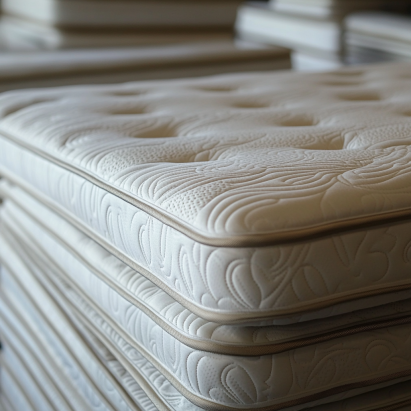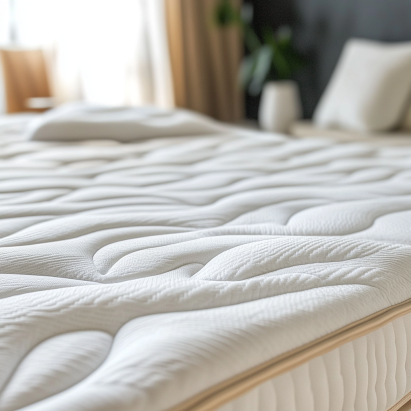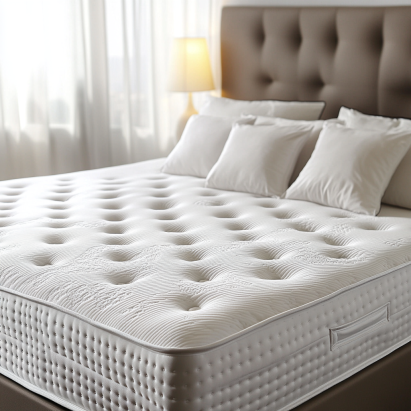Mattress Firmness Levels Explained: Find the Perfect Comfort for Your Sleep
Mattress firmness levels determine how soft or firm your bed feels. Learn how to choose the perfect firmness for your sleep style with our detailed guide.
Key Takeaways on Mattress Firmness
- Mattress firmness levels range from 1 (extra soft) to 10 (extra firm).
- Side sleepers benefit from softer mattresses; back and stomach sleepers need more support.
- Body weight and sleep position significantly affect firmness preference.
- Testing a mattress before buying ensures better sleep comfort.
What is Mattress Firmness?
Mattress firmness refers to how soft or firm a mattress feels when you lie on it. It’s subjective, depending on factors like body weight, sleep position, and personal preferences. Mattress brands typically use a scale from 1 to 10 to categorize mattress firmness levels, making it easier for buyers to find their perfect match. For a full comparison, check our mattress types overview.
Understanding the Mattress Firmness Scale
The firmness scale ranges from extra soft to extra firm:
- 1–3: Extra Soft to Soft
- 4: Medium-Soft
- 5: Medium
- 6–7: Medium-Firm
- 8–10: Firm to Extra Firm
1. Extra Soft to Soft (1-3)

Extra soft mattresses feel plush and sink-in soft, offering a luxurious sleeping experience. They’re ideal for side sleepers who need extra cushioning for their shoulders and hips. However, they may lack the support necessary for proper spinal alignment, especially for back or stomach sleepers.
Soft mattresses (rated 2–3) are a step up in support but still emphasize comfort. They’re often favored by lighter individuals or those who love a “cloud-like” feel.
2. Medium-Soft (4)

Medium-soft mattresses balance plushness and support. They cradle the body without excessive sinking, making them perfect for combination sleepers who shift between positions throughout the night. If you enjoy the softness of a mattress but need a bit more stability, medium-soft options may be your best bet.
3. Medium (5)

A medium mattress is the most versatile option on the scale. It offers a balance of softness and firmness that works well for couples with differing sleep preferences. Back sleepers often find medium mattresses supportive, as they provide enough give to contour the spine while preventing excessive sagging.
4. Medium-Firm (6-7)

Medium-firm mattresses are the universal comfort level, recommended for most sleepers. They’re ideal for back and stomach sleepers, offering the support needed to keep the spine aligned while maintaining a touch of cushioning. Medium-firm mattresses are also a popular choice for those with back pain, as they reduce pressure points without compromising support.
5. Firm to Extra Firm (8-10)

Firm and extra firm mattresses provide maximum support, making them a top choice for stomach sleepers and individuals with higher body weights. These mattresses help distribute weight evenly and maintain a neutral spine. While they may feel too rigid for lighter sleepers, they’re excellent for those who need a solid surface to prevent sinking.
Factors That Affect Mattress Firmness Preferences

While the firmness scale is a helpful guide, personal factors influence how you perceive mattress firmness levels:
- Sleep Position
- Side Sleepers: Benefit from softer mattresses to cushion pressure points.
- Back Sleepers: Medium to medium-firm mattresses support spinal alignment.
- Stomach Sleepers: Firmer mattresses prevent hips from sinking.
- Body Weight: Heavier individuals typically feel softer mattresses are too plush, while lighter individuals may find firm mattresses too rigid. Choose a firmness level that complements your weight for optimal comfort.
- Additional Factors: Consider health conditions like back pain, the type of materials used in the mattress, and even room temperature. Memory foam, for example, adapts to body heat, creating a softer feel. Learn the difference between memory foam and spring mattresses here.
Testing Mattress Firmness
Before committing to a mattress, test it out. Lie down in your usual sleeping position and spend at least 10–15 minutes assessing its comfort and support. Many retailers offer in-home trials, allowing you to test a mattress over several nights to ensure it’s the right fit.
FAQ
- What is the best mattress firmness for side sleepers?
- Soft to medium mattresses are ideal for cushioning pressure points.
- Do firmer mattresses last longer?
- Firm mattresses often maintain shape longer, but longevity depends on materials used.
- Is memory foam always soft?
- Memory foam adapts to your body but comes in different firmness levels.
Conclusion
Understanding mattress firmness levels is the first step to finding your ideal mattress. From extra soft to extra firm, each level caters to specific sleep needs and preferences. By considering factors like sleep position, body weight, and materials, you can make an informed choice that leads to restful, rejuvenating sleep every night.























